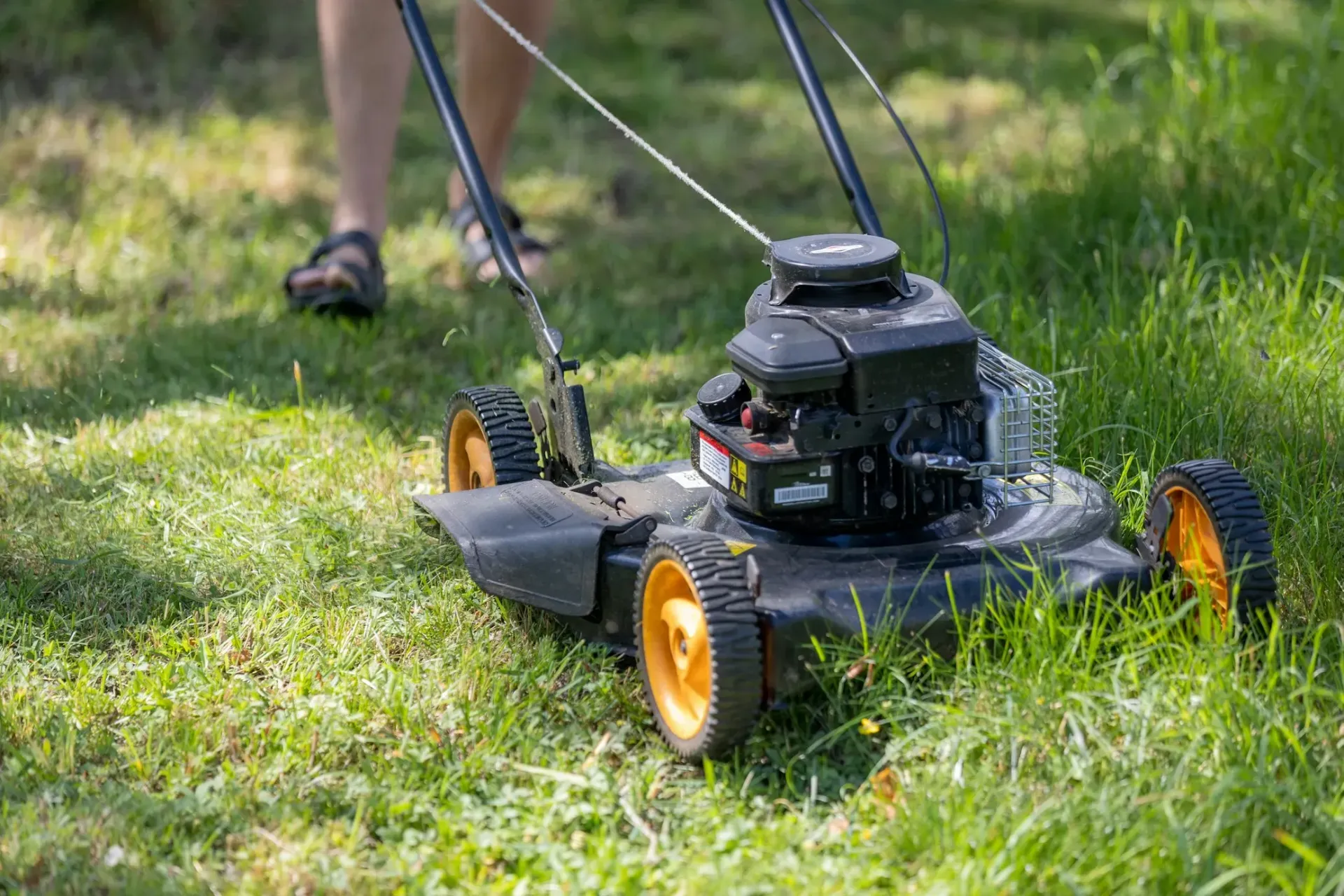How Often Should Lawn Be Mowed?
A well-kept lawn is a source of pride for any homeowner. Knowing how often to mow your lawn is key to keeping it healthy and looking great. Mow too often, and you might hurt the grass. Mow too little, and your yard might look messy.

What Factors Affect Lawn Growth?
How do climate and weather conditions impact growth?
Climate and weather are big factors in how your lawn grows. Warm and wet conditions make grass grow quickly. Dry or cold weather slows it down. Understanding these conditions helps you decide how often to mow.
How does the type of grass affect mowing frequency?
Different types of grass have different growth rates. For example, warm-season grasses like Bermuda and Zoysia grow fast in summer. Cool-season grasses like Kentucky Bluegrass and Fescue grow best in spring and fall. Knowing your grass type helps you set a mowing schedule.
What role does soil quality and fertility play?
Good soil means strong grass. Fertile soil with the right nutrients helps grass grow well. Poor soil can slow growth and make your lawn look thin. Testing your soil and adding the right nutrients can improve lawn health and affect how often you need to mow.
What Are the Recommended Mowing Frequencies?
What are the general guidelines for warm-season grasses?
Warm-season grasses like Bermuda, Zoysia, and St. Augustine thrive in the heat. During the growing season, these grasses should be mowed every 5 to 7 days. This frequent mowing keeps them healthy and prevents thatch buildup. In cooler months, mowing can be reduced as growth slows down.
What are the general guidelines for cool-season grasses?
Cool-season grasses, such as Kentucky Bluegrass, Fescue, and Ryegrass, grow best in cooler temperatures. These grasses usually need mowing every 7 to 10 days during spring and fall. In summer, when growth slows, you can extend the interval to every 10 to 14 days.
How should mowing frequency change with the seasons?
How often should you mow in spring? Spring is a time of rapid growth for both warm and cool-season grasses. Plan to mow your lawn every 5 to 7 days. This helps keep the grass at the ideal height and prevents it from getting too long.
How often should you mow in summer?
In summer, warm-season grasses continue to grow rapidly, requiring mowing every 5 to 7 days. Cool-season grasses grow more slowly and can be mowed every 10 to 14 days. Be mindful of dry spells and adjust your mowing schedule accordingly.
How often should you mow in fall?
Fall is another peak growing period for cool-season grasses. Mow every 7 to 10 days to maintain a healthy lawn. For warm-season grasses, mowing can be less frequent, about every 10 to 14 days, as growth slows down.
How often should you mow in winter?
During winter, most grasses grow very slowly or go dormant. You might not need to mow at all, or only once a month, depending on your grass type and climate.
What Are the Signs Your Lawn Needs Mowing?
What are the visual indicators that mowing is needed?
How tall should the grass be before mowing?
A good rule of thumb is to never cut more than one-third of the grass blade at a time. For most lawns, this means mowing when the grass is about 3 to 4 inches tall. Keeping your lawn at a consistent height helps it stay healthy and lush.
How does thatch buildup indicate mowing needs?
Thatch is a layer of dead grass, roots, and debris that builds up on the soil surface. If you notice a thick layer of thatch, it's a sign that your lawn might need more frequent mowing. Regular mowing helps prevent thatch buildup by promoting healthy grass growth.
What are the performance indicators?
How does lawn health show mowing needs?
Healthy lawns have a consistent color and density. If you notice patchy areas, discoloration, or uneven growth, it might be time to adjust your mowing frequency. Regular mowing encourages even growth and helps keep your lawn looking its best.
How does weed growth indicate mowing frequency?
Weeds can quickly take over if your lawn is not mowed regularly. Frequent mowing keeps weeds in check by cutting them before they can spread seeds. If you see an increase in weeds, it might be a sign to mow more often.
What Are the Best Practices for Lawn Mowing?
What mowing techniques should you use?
How often should you sharpen mower blades?
Sharp mower blades are crucial for a clean cut. Dull blades tear the grass, causing damage and making the lawn look ragged. It's best to sharpen your mower blades every 20 to 25 hours of use, or at least once per mowing season.
What is the ideal cutting height for different grasses?
Each grass type has an ideal cutting height:
- Bermuda grass: 1 to 1.5 inches
- Zoysia grass: 1 to 2 inches
- St. Augustine grass: 2.5 to 3 inches
- Kentucky Bluegrass: 2.5 to 3.5 inches
- Fescue grass: 2.5 to 4 inches Cutting at the recommended height helps maintain healthy roots and prevents stress on the grass.
How can you maintain a healthy mowing schedule?
How to develop a consistent mowing routine?
Creating a mowing schedule based on your grass type and seasonal growth patterns is key. Set reminders or mark your calendar to keep track of mowing days. Consistency helps your lawn stay healthy and attractive.
What are the benefits of regular mowing?
Regular mowing has several benefits:
- Healthier Grass: Keeps the lawn at an optimal height, promoting strong roots and thick growth.
- Weed Control: Reduces the chance for weeds to establish and spread.
- Thatch Prevention: Helps prevent the buildup of thatch by promoting even growth.
- Aesthetic Appeal: Ensures your lawn looks neat and well-maintained.
The Bottom Line
Mowing your lawn regularly and at the right frequency is crucial for maintaining a healthy, lush yard. Understanding the factors that affect lawn growth, setting an appropriate mowing schedule, and following best practices can help you achieve a beautiful lawn. Remember to keep an eye on signs that your lawn needs mowing and adjust your routine based on the season and weather conditions.
Ready to take your lawn care to the next level? Trust the experts at ProYards for all your yard maintenance needs. Whether you're in Salt Lake City, Lehi, Saratoga Springs, Eagle Mountain, or American Fork, our team is here to help.
Why Choose ProYards?
At ProYards, we are committed to providing top-notch yard care services in Salt Lake, Davis, and Utah counties. Our services include:
- Fertilization
- Hardscapes
- Irrigation
- Landscaping
- Lawn Care
- Tree Service
- Pest Control
Our team is fully licensed and insured, ensuring your peace of mind while we work on your property. We understand the importance of having a beautiful and healthy lawn, and that's why we guarantee high-quality results every time. With our expertise in lawn and yard care, we can transform your outdoor space into a stunning oasis.
At ProYards, we take pride in our professionalism and attention to detail. Our team is dedicated to providing the best customer experience, from the initial consultation to the final result.
Contact ProYards today and let us help you achieve the lawn of your dreams!
Our Services
Contact Information
Phone: (801) 254-2890
Email: proyardcustomers@gmail.com
Business Hours
- Mon - Fri
- -
- Sat - Sun
- Closed
Area We Serve
All Rights Reserved | Proyards









